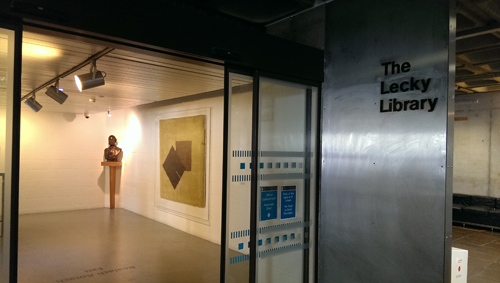Eileen Gray 'Castellar'
(Designed 1926, woven 1975) wool, long-pile rug, hand-woven and knotted wool by The Donegal Carpet Company, Ireland
Location: The entrance hall to The Lecky Library, Trinity College Dublin

Born in 1878 in County Wexford, Eileen Gray was one of the leading protagonists of a revolution in design, in both theory and practice, spreading across Europe during the 20th century. At the age of 20, she became one of the first women to enroll at the Slade School of Fine Art, London, where she studied painting before undertaking an apprenticeship in lacquerware, a material with which she later became synonymous.
Her affinity for this material, and her continued training in other forms of industrial design, later led to the production of lacquered screens and decorative panels embodying the contemporaneous Art Deco style of the 1920s and 1930s. She had moved to Paris, the fulcrum of the Avant-Garde, in 1902 during her formative years as a lacquerware artist, and, notably, caused a stir when she exhibited a stark white lacquered boudoir at the 14th Salon des Artistes Décorateurs in 1923.
Her lifelong passion for experimentation is reflected in the diversity of materials she employed, from lacquer to wool, wood, leather, cellulose acetate, chrome, tubular steel, aluminium and, of course, concrete in the form of her built architectural designs, each translated from concept to reality by means of adept and beautiful designs, themselves worthy of a place in any art gallery.
A friend of the architects Mies van der Rohe and Le Corbusier, she shared and often influenced, their passion for modern, clean-lined, functional design. She worked at the forefront of contemporary movements in each aspect of her practice. As an architect, she embraced the Modernist Bauhaus aesthetic, this approach to a unified design aesthetic complimenting and further inspiring the range of her practice. Two of the houses she designed, E-1027 in Roquebrune-Cap-Martin and Tempe á Pailla in Castellar, France, were built between 1926 and 1934, and are deemed some of the purest examples of domestic architecture of the period.
‘I should so like to have a carpet made in Ireland’
A long-lasting wish of Gray’s was to have her rugs made in her home country, Ireland. After her 1973 exhibition in Dublin, the art critic Dorothy Walker encouraged her to pursue that wish. Donegal Carpets and V’Soske Joyce both appealed to the artist for the rights to reproduce her designs. However, as V’Soske Joyce expressed a wish to alter Gray’s original designs and would not produce them by hand, it was Donegal Carpets who ultimately won the commission. Although Gray found the pile of Donegal Carpets very thick, she was happy with the rugs which were then sold through her London-based agent, Monica Kinley. At Trinity College Dublin, we have two rugs in this series produced in Ireland – Zara and Castellar, the latter is on display in the entrance to The Lecky Library and was made in 1975, what was to be the penultimate year of Gray’s life.
Castellar is based on Gray’s 1926 designs, one painted and the other a mixed media collage, both of which were exhibited together with the Trinity College rug at the special request of the National Museum of Ireland and the Musée National de l’Art Moderne at the Centre Pompidou, Paris, for the Irish iteration of the exhibition Eileen Gray: Architect, Designer, Painter staged at the Irish Museum of Modern Art, Dublin from October 2013 to January 2014. Demonstrating Gray’s holistic approach to all aspects of design, the central motif of the rug is based on the architectural plan of Tempe á Pailla, one of her realised and lauded architectural designs. This rug design displays her interest in the styles of Cubism, De Stijl and an affinity with the work of artist Kasimir Malevich, in particular, in this analytical, minimalist and abstract composition. Castellar is also known as Brentano, the name of a popular bookshop close to Gray’s Parisian home.
Selected further information on Eileen Gray:
Goff, Jennifer Eileen Gray. Her Work and Her World (Dublin: Irish Academic Press, 2014)
The National Museum of Ireland archive
The Architectural Review: www.architectural-review.com/eileen-gray-pioneer-of-design-december-1972/8659684.article
Written and researched by Catherine Giltrap, Curator, and Carolyn Kelly, Assistant Curator

